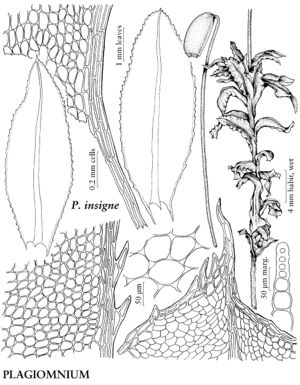Plagiomnium insigne
Ann. Bot. Fenn. 5: 146. 1968.
Erect stems 3–8 cm, not dendroid; sterile stems to 10 cm. Leaves dark green, green, or yellow-green, crisped and contorted when dry, flat when moist, elliptic, narrowly elliptic, or occasionally ovate or oblong, (3–) 5–9 (–11) mm; base broadly long-decurrent; margins toothed to near base, teeth sharp, of 1 or 2 cells; apex acute, acuminate, or occasionally obtuse or rounded, cuspidate, cusp toothed; costa excurrent, percurrent, or rarely subpercurrent; medial laminal cells usually short-elongate or ± isodiametric, 40–70 (–80) µm, somewhat smaller near margins to about 1/2 size, in weakly defined longitudinal rows, rarely in diagonal rows, collenchymatous, walls pitted, pits often indistinct; marginal cells linear, in 3–4 (–5) rows. Sexual condition dioicous. Seta 3–6 (–8), reddish proximally, yellow distally, 2–4 cm. Capsule pendent, cylindric, 3.5–4.5 mm, neck not distinct; operculum conic-apiculate. Spores 20–25 µm.
Phenology: Capsules mature late spring.
Habitat: Humus or soil in shaded habitats in forests, along trails, lawns in urban habitats
Elevation: low to moderate elevations
Distribution

B.C., Alaska, Calif., Idaho, Mont., Oreg., Wash., Wyo.
Discussion
Plagiomnium insigne is typically a large species, often forming extensive mats or turfs. It is fairly common in forests and in shaded urban habitats along the west coast. Plagiomnium medium is usually smaller, lighter green, and found in generally wetter habitats than P. insigne. According to T. J. Koponen (1974), older fertile stems of P. medium are more densely covered with rhizoids than those of P. insigne that are nearly rhizoid free.
Selected References
None.
